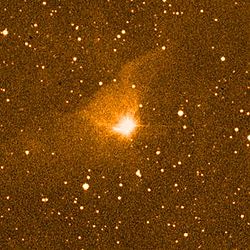
FU Orionis
Encyclopedia

Stellar evolution
Stellar evolution is the process by which a star undergoes a sequence of radical changes during its lifetime. Depending on the mass of the star, this lifetime ranges from only a few million years to trillions of years .Stellar evolution is not studied by observing the life of a single...
, an FU Orionis star (also FU Orionis object, or FUor) is a pre–main sequence star which displays an extreme change in magnitude and spectral type. One example is the star V1057 Cyg, which became 6 magnitudes brighter and went from spectral type dKe
DKE
DKE is a three-letter abbreviation with multiple meanings, as described below:* Data and Knowledge Engineering* Deutsche Kommission Elektrotechnik Elektronik Informationstechnik im DIN und VDE * Delta Kappa Epsilon...
to F supergiant. These stars are named after their type-star, FU Orionis
FU Orionis
In stellar evolution, an FU Orionis star is a pre–main sequence star which displays an extreme change in magnitude and spectral type. One example is the star V1057 Cyg, which became 6 magnitudes brighter and went from spectral type dKe to F supergiant...
.
The current model associates the FU Orionis flare with abrupt mass transfer from an accretion disc
Accretion disc
An accretion disc is a structure formed by diffuse material in orbital motion around a central body. The central body is typically a star. Gravity causes material in the disc to spiral inward towards the central body. Gravitational forces compress the material causing the emission of...
onto a young, low mass T Tauri star
T Tauri star
T Tauri stars are a class of variable stars named after their prototype – T Tauri. They are found near molecular clouds and identified by their optical variability and strong chromospheric lines.-Characteristics:...
. Mass accretion rates for these objects are estimated to be around 10−4 solar mass
Solar mass
The solar mass , , is a standard unit of mass in astronomy, used to indicate the masses of other stars and galaxies...
es per year. The rise time of these eruptions is typically ~ 1 year, but can be much longer. The lifetime of this high accretion, high luminosity phase is on the order of decades. However, even with such a relatively short timespan, an FU Orionis object has yet to be observed shutting off. By comparing the number of Fuor outbursts to the rate of star formation in the solar neighborhood, it is estimated that the average young star undergoes approximately 10-20 Fuor eruptions over its lifetime.
The prototypes of this class are: FU Orionis
FU Orionis
In stellar evolution, an FU Orionis star is a pre–main sequence star which displays an extreme change in magnitude and spectral type. One example is the star V1057 Cyg, which became 6 magnitudes brighter and went from spectral type dKe to F supergiant...
, V1057 Cygni
V1057 Cygni
V1057 Cygni is a FU Orionis-type variable star in the constellation of Cygnus. It has a spectral type of F and an apparent visual magnitude of approximately 11.660. It was the second FU Orionis-type variable discovered....
, V1515 Cygnihttp://simbad.u-strasbg.fr/sim-id.pl?protocol=html&Ident=V1515+cyg, and the recent addition the embedded protostar
Protostar
A protostar is a large mass that forms by contraction out of the gas of a giant molecular cloud in the interstellar medium. The protostellar phase is an early stage in the process of star formation. For a one solar-mass star it lasts about 100,000 years...
V1647 Orionishttp://simbad.u-strasbg.fr/sim-id.pl?protocol=html&Ident=V1647+ori, which erupted in 2004 January.
External links
- The Furor over FUOrs (15 Nov 2010)
- Discovery of possible FU-Ori and UX-Ori type objects (18 Nov 2009)
- http://www.aavso.org/vstar/vsots/0202.shtml

